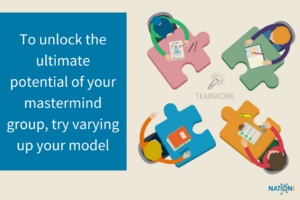Struggling to kick some bad habits in your gig economy career or take things to the next level? A mastermind group could be the answer you’ve been looking for! In addition to the many benefits associated with the practice, we’ll explore below how to find a mastermind group and how to run a mastermind group your own.
As freelancers and solopreneurs, we put such a burden on ourselves to succeed that we often feel paralyzed without the support of the peers we might have had in traditional jobs. You are not alone in going freelance, but you can feel alone. When you’re working out of a home office and doing all your work via Slack, email and Google docs, how you combat isolation and reinvigorate your productivity?
It’s time to find a mastermind group.
Are you looking for ideas on how to grow your freelance career? We put together the best ideas from across Nation1099 into an ebook — 15 Easy Hacks For Finding More Freelance Clients. Even better, this ebook includes two fantastic giveaways to valuable services.
What is a mastermind group?
A mastermind group is a small number of professionals with similar business or career goals and a similar levels of development who come together for mutual motivation and support. They may all be in the same field or a mix of professionals from different areas of expertise.
The concept of a mastermind group was popularized by renowned self-help author Napoleon Hill. He defined he mastermind group as “two or more people who work in perfect harmony for the attainment of a definite purpose.”
Hill got the idea to Andrew Carnegie, who credits the “master mind” — a group of about 50 colleagues — with his path from rags to the richest person in America.

In more concrete terms, a mastermind group is a support team of like-minded individuals — be they CEOs, freelance designers or race car drivers — who provide each other with a critical system of accountability, professional guidance, creative problem solving and mutual support.
Growing a stronger professional network is always an asset, but the freelance lifestyle can make it difficult to connect with peers in a meaningful way. But when you join a mastermind group, it’s more than just networking.
The best mastermind groups for consultants force you to learn and to grow.
What do you get from a mastermind group?
Many advantages of the mastermind group are so obvious that they are often overlooked: the emotional support of confiding in others, the value of getting multiple perspectives on a business problem, the crucial networking opportunities.
And don’t forget encouragement . . .

Of all of the benefits, accountability reigns supreme. The simple fact is, when we talk to others about what we’re doing and what we aim to do, we have a much greater chance of keeping ourselves on track to accomplish these things!
Whether it comes down to pride or our desire not to let others down, the regular act of sharing our goals and progress on them is often the push we need to make serious headway in achieving our dreams.
Read more: How To Be More Productive With Your Accountability Group
Nation1099 contributor and solo consultant Curtis McHale refers to this benefit as “crowdsourcing your coaching.” A coach will keep you in line — but five coaches will make sure you do what you say you’re going to do! His full interview with Cory Miller of ithemes is an excellent window into this unique dynamic.
Read Curtis’ post on strategically getting more freelance consulting jobs.
How do you find a mastermind group?
Naturally, you have two choices when trying to find a mastermind group — join one or create your own. LinkedIn, Meetup.com and Craigslist are some of the best resources.
You can also ask friends and freelance colleagues in your area and if they know of any local mastermind groups or if they have any interest in joining one.
We’re going to go into all the possible ways to find a mastermind group below, but we strongly believe that just starting your own group is the most effective strategy. Some people are organizers, and some are joiners (or just shy). If you are the later, push your boundaries here to start a mastermind group yourself, because the results are much more likely to suit your needs.

When you are searching for a mastermind group, you will find some that meet online via Skype or Google Hangouts, but traditionally mastermind groups meet in-person. As self-employed individuals, we do so much work at a distance that it’s truly a treat to meet with peers face-to-face.
If you are thinking, “I have no peers,” because you are in a very specialized field, then turn that to your advantage. You don’t have to get support and advice from other people providing the exact same professional service that you do.
Your real peers are people who are serious about growing their freelance businesses, even if they work in a different field entirely. Don’t hesitate to find a mastermind group made up of people in unfamiliar industries.
Related reading: How Many Different Freelance Careers Do You Know Of? We’ve Found Over 130 So Far
The new perspectives you get when you find a mastermind group made up of people from different industries should be a plus. You’ll learn about different pricing models or marketing tactics that you can consider trying in your own area where they may be seen as innovations.
What does a mastermind group cost?
Most mastermind groups are free. Some mastermind groups do charge a membership fee, but this isn’t necessarily a bad a thing. As those of us with gym memberships can attest, having even a little money on the line can help us treat our goals with greater seriousness and increase our personal accountability.

The fees for a mastermind group can range from the cost of the weekly lunch buffet to tens of thousands of dollars annually for “exclusive access” to industry elites.
In between that range, the costs of a mastermind group are determined by the intensity of programming and planning. Some are essentially min-conferences or workshops with professional coaches or speakers, and the group fee reflects that.
Also, having a small budget can allow your group to do some pretty cool things with your mastermind group, like taking field trips or attending educational seminars.
7 easy ways to find a mastermind group:
- Post a flyer in your favorite coworking space or coffee shop.
- Look for relevant groups across your social media channels (Facebook, Twitter, LinkedIn, etc.) and make a post inquiring about starting a mastermind group.
- Go to a local networking or professional learning event and ask around.
- Reach out to local or remote individuals who you deeply respect in your field (they might also be trying to find a mastermind group!)
- Look at your own email list. If you have a listbuilder on your professional website to capture business leads, at least some of the people who sign up are probably peers who are just interested in how you work.
- Don’t forget to localize your Google results by adding the name of your city or town when you search for mastermind groups.
- Just ask your colleagues and peers to form one with you.

Evidence that mastermind groups work
Unfortunately, there hasn’t much in the way of surveys or studies on mastermind groups, but the evidence in favor of them is accumulating.
The Power of Peer Coaching by By Lynda C. McDermott details the history of peer advisory education and how that connects to C-suite and leadership development.
Woman and Leadership: Examining the Impact of Entrepreneurial Education on Leadership Self-Efficacy is a study by Veronica Guerrero for the U.S. Association for Small Business and Entrepreneurship. It finds that:
“experiential learning situations, the establishment of support networks, and reflective self-assessments all contribute to effective learning among nascent female entrepreneurs. Ninety percent of the participants indicated that experiential activities positively impacted their development. Sixty two percent of the participants shared how the cultivation of peer-support networks accelerated the entrepreneurial process by providing a forum for personal accountability, skill development and inspiration.”
For something more anecdotal, be sure to check out Dorie Clark’s writing about mastermind groups in HBR and elsewhere. She documents the personal stories of people who have benefited from them.
And for a really inspiring testimonial about the power of mastermind groups, see this article in Forbes by Cole Harmonson about founding and growing his company Far West Capital. He writes especially about the power of the journaling work he still maintains “every day, checking in with my own spiritual, mental, emotional, physical and fiscal status, reporting back to myself where I was on each front.”
What kinds of mastermind groups are there?
- Business roundtables are intended for business owners or CEOs.
- Weekly affinity group lunch. A group with a common interest — working in startups or in a particular kind of role — have a standing reservation at a local buffet joint. Over time a core group gets to know one another and to build up some momentum to their conversations.
- Online mastermind groups. Remote via video chat software.
- Traditional. Four or five friends in a coffee shop or for breakfast once a week.

Another way of thinking about the types of mastermind groups is to notice that they organized in one of these ways:
- Role-based mastermind groups. Everyone does the same kind of work or is at the same point in their career.
- Mission-based mastermind groups. Everyone want to make a similar big picture change in their community.
- Topic-based mastermind groups. Everyone wants to discuss the same themes or issues.
- Activity-based mastermind groups. Everyone wants to spend the meeting periods in a particular way.
- Industry-based mastermind groups. Everyone is working in the same vertical.
- Business-based mastermind groups. Everyone wants to achieve similar results for their business, even if they aren’t in the same role or industry.
Who should you include in your mastermind group?
The average mastermind group has between four and eight members, but they can be as small as two and as large as 20.
In the case of busy solopreneurs, it’s best to start small and build it out from there. Too many members may dilute the intimate nature of the mastermind group and disorganize meetings.
It’s also crucial that you and your team be a little picky about who you admit. Members do not need to work in the same industries, but need to have enough common ground to present mutual benefits to each other. Having many different kinds of freelancers involved helps each member grow their professional network.
Commitment is non-negotiable, though. The effectiveness of a mastermind group hinges on the respect all members have for it and their ability to treat it as a high priority. One member who does not share this same vision can undermine the entire collaboration.
How to run a mastermind group
Perhaps you’ve chatted with a few friends and have generated some interest in starting a mastermind group — great! But what do you do now, and how do you actually run a mastermind group?
Most mastermind groups need some kind of facilitator. This designated person keeps meetings on task and on schedule and also helps ensure that members are comfortable and in good spirits.
No one says there has to be only one facilitator! You might have multiple members who are able to run a mastermind group, while each bringing their own strengths to the table.

Fortunately, there are many effective ways a facilitator can run a mastermind group and structure meetings to best suit the needs of its members. Let’s dig in below.
Model 1: One success, one obstacle and one resource to share
One of the simplest but most effective models for mastermind groups is the three-topic breakdown. These topics can be whatever your group agrees to, these three work well.
You go around the circle once so each member can share first one success. Others can respond and ask questions, and the facilitator watches the clock to move things along so everyone gets a chance to share. Then you move on to sharing one obstacle and then one resource.
This model gives structure to the mastermind meeting and pushes members to evaluate their progress and to set goals. Put simply, this model emphasizes accountability, which is crucial to running a mastermind group effectively.
Model 2: The hot seat
There is always so much to explore in a mastermind meeting. Inevitably there are many topics and updates that get skimmed over that would interesting to discuss at length. The hot seat model of running a mastermind group makes room for this kind of deep-dive.
In this format members go around in a circle reporting on their problems and successes for the week, just as in the former example. However, each person is limited to a few minutes, and then the hot seat period of the meeting begins.
The group chooses a member to take the hot seat and that person has an audience for 30 minutes to talk in depth about major difficulties he or she may be having in growing their freelance business. The exercise cycles through one member a week, giving everyone a chance to get feedback on their challenges.
This model is best tailored to small, intimate groups. The ideal scenario is that each member of the mastermind group gets one hot seat per month.

Model 3: Beginning, middle (topical), end
Diversity is the spice of life — and the spice of your mastermind group! Things can get a little stale if every week feels like a repeat of the last. This model gives the group and the facilitator the ability to vary the content of each week’s meeting and create a livelier routine for the mastermind group.
Professional blogger Tom Ewer captures a good breadth of these growth activities on his freelance blogging website, Leaving Work Behind.
“This could be featuring one member who is launching or struggling, a guest speaking to members or one member instructing and answering questions on a particular area of expertise,” says Ewer.
As you can see, flexibility and variety are the biggest benefits of this way of running a mastermind group, but stability and consistency can be difficult to maintain.
This method may also require some additional planning. For these reasons this model isn’t the best for new mastermind groups. It can be a great way to shake things up once a month when the familiar model begins to feel stale.
Set up for success
It may very well pay to have a few different factors that you change each week — whether the hot seat, the topic or moderator. Each of these models have unique strengths, so consider giving them all a shot. Take the things you like most about each and build them into your unique mastermind process!
As with solopreneurship and the gig economy in general, you get out what you put into a mastermind group. The great thing about this tool is that, by its very design, you are get motivated to do your best and grow your freelance business.
Humans are social animals (even if some of us are also solopreneurs), and the power of community is still essential to our success. You may be independent, but you don’t need to go it alone. Find a mastermind group that will help you turn your passion into action and take your career to the next level.

Ben Shanbrom is a freelance writer, musician and copy editor who works with artists and other clients around his native New Haven and well beyond.















Well done article! As entrepreneurs, we need to connect with other entrepreneurs to share best practices and solve problems. Why go it alone when there are others out there who can help (and who you can help in return)?
Hi Karyn! Thanks a bunch for giving this a read and weighing in on the topic. Collaboration with other solos is so important and a point that many people almost need to reprogram their thinking on. We’d love to get your thoughts on optimizing the mastermind group!
Everyone quotes Napoleon Hill. Did you know that the Renaissance art movement was also a mastermind group?
The isolation for entrepreneurs is real and they need help and support. One of the best things about mastermind groups is that no-one is selling to you. Its just advice and support form a group of peers and friends.
Hi Ronan, thanks for chiming in here. You’re definitely right about Napoleon Hill being the go-to quote subject on the topic. As you pointed out, mastermind groups are a very old practice (I was aware of the Renaissance connection! On a more literary level, many now regard King Authur’s Knights of the Round Table as a sort of mythic mastermind group) and while some of this I know is old hat to people who have lived the practice for a long time, many young freelancers and creatives are not familiar with the term or its rich history. I felt it was important to give a little of that background in the introduction to this guide.
I’ve started a “Mastermind” group, and our first session is next week! We plan to address a specific topic once a month, and we’ll start with branding/identity for our first session. Do you know of any workbooks/topic guides that have been published for groups like these? I want to make sure that each month has a structured, focused conversation so we can all walk away having learned something and feeling empowered.